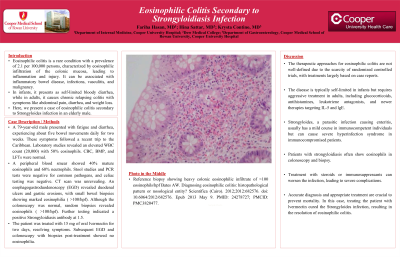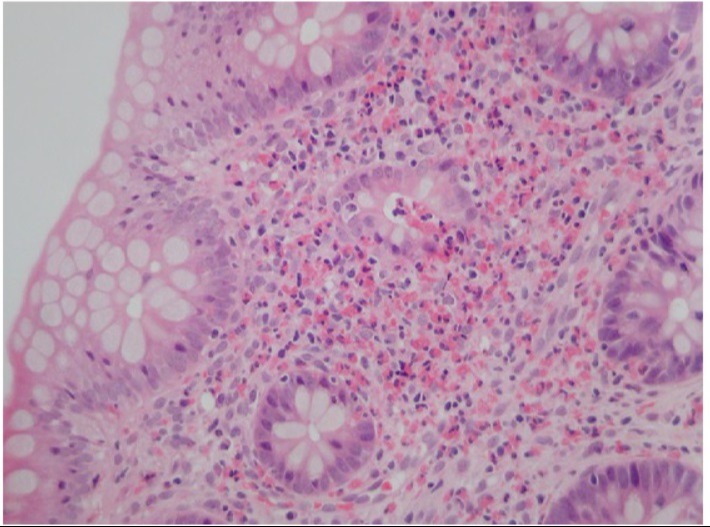Sunday Poster Session
Category: Colon
P0310 - Eosinophilic Colitis Secondary to Strongyloidiasis Infection
Sunday, October 27, 2024
3:30 PM - 7:00 PM ET
Location: Exhibit Hall E

Has Audio

Fariha Hasan, MD
Cooper University Hospital
Philadelphia, PA
Presenting Author(s)
Fariha Hasan, MD1, Hina Sattar, MD2, Krysta Contino, MD3
1Cooper University Hospital, Philadelphia, PA; 2Dow Medical College, Karachi, Sindh, Pakistan; 3Digestive Health Institute at Cooper University Hospital, Mount Laurel, NJ
Introduction: Eosinophilic colitis is a rare condition with a prevalence of 2.1 per 100,000 persons, characterized by eosinophilic infiltration of the colonic mucosa, leading to inflammation and injury. It can be associated with inflammatory bowel disease, infections, vasculitis, and malignancy. In infants, it presents as self-limited bloody diarrhea, while in adults, it causes chronic relapsing colitis with symptoms like abdominal pain, diarrhea, and weight loss. Here, we present a case of eosinophilic colitis secondary to Strongyloides infection in an elderly male.
Case Description/Methods: A 79-year-old male presented with fatigue and diarrhea, experiencing about five bowel movements daily for two weeks. These symptoms followed a recent trip to the Caribbean. Laboratory studies revealed an elevated WBC count (20,000) with 50% eosinophils. CBC, BMP, and LFTs were normal. A peripheral blood smear showed 40% mature eosinophils and 60% neutrophils. Stool studies and PCR tests were negative for common pathogens, and celiac testing was negative. CT scan was unrevealing. An esophagogastroduodenoscopy (EGD) revealed duodenal ulcers and gastric erosions, with small bowel biopsies showing marked eosinophilia ( >100/hpf). Although the colonoscopy was normal, random biopsies revealed eosinophils ( >100/hpf). Further testing indicated a positive Strongyloidiasis antibody at 1.5. The patient was treated with 15 mg of oral Ivermectin for two days, resolving symptoms. Subsequent EGD and colonoscopy with biopsies post-treatment showed no eosinophilia.
Discussion: The therapeutic approaches for eosinophilic colitis are not well-defined due to the scarcity of randomized controlled trials, with treatments largely based on case reports. The disease is typically self-limited in infants but requires aggressive treatment in adults, including glucocorticoids, antihistamines, leukotriene antagonists, and newer therapies targeting IL-5 and IgE. Strongyloides, a parasitic infection causing enteritis, usually has a mild course in immunocompetent individuals but can cause severe hyperinfection syndrome in immunocompromised patients. Patients with strongyloidiasis often show eosinophils in colonoscopy and biopsy. Treatment with steroids or immunosuppressants can worsen the infection, leading to severe complications. Accurate diagnosis and appropriate treatment are crucial to prevent mortality. In this case, treating the patient with Ivermectin cured the Strongyloides infection, resulting in the resolution of eosinophilic colitis.

Disclosures:
Fariha Hasan, MD1, Hina Sattar, MD2, Krysta Contino, MD3. P0310 - Eosinophilic Colitis Secondary to Strongyloidiasis Infection, ACG 2024 Annual Scientific Meeting Abstracts. Philadelphia, PA: American College of Gastroenterology.
1Cooper University Hospital, Philadelphia, PA; 2Dow Medical College, Karachi, Sindh, Pakistan; 3Digestive Health Institute at Cooper University Hospital, Mount Laurel, NJ
Introduction: Eosinophilic colitis is a rare condition with a prevalence of 2.1 per 100,000 persons, characterized by eosinophilic infiltration of the colonic mucosa, leading to inflammation and injury. It can be associated with inflammatory bowel disease, infections, vasculitis, and malignancy. In infants, it presents as self-limited bloody diarrhea, while in adults, it causes chronic relapsing colitis with symptoms like abdominal pain, diarrhea, and weight loss. Here, we present a case of eosinophilic colitis secondary to Strongyloides infection in an elderly male.
Case Description/Methods: A 79-year-old male presented with fatigue and diarrhea, experiencing about five bowel movements daily for two weeks. These symptoms followed a recent trip to the Caribbean. Laboratory studies revealed an elevated WBC count (20,000) with 50% eosinophils. CBC, BMP, and LFTs were normal. A peripheral blood smear showed 40% mature eosinophils and 60% neutrophils. Stool studies and PCR tests were negative for common pathogens, and celiac testing was negative. CT scan was unrevealing. An esophagogastroduodenoscopy (EGD) revealed duodenal ulcers and gastric erosions, with small bowel biopsies showing marked eosinophilia ( >100/hpf). Although the colonoscopy was normal, random biopsies revealed eosinophils ( >100/hpf). Further testing indicated a positive Strongyloidiasis antibody at 1.5. The patient was treated with 15 mg of oral Ivermectin for two days, resolving symptoms. Subsequent EGD and colonoscopy with biopsies post-treatment showed no eosinophilia.
Discussion: The therapeutic approaches for eosinophilic colitis are not well-defined due to the scarcity of randomized controlled trials, with treatments largely based on case reports. The disease is typically self-limited in infants but requires aggressive treatment in adults, including glucocorticoids, antihistamines, leukotriene antagonists, and newer therapies targeting IL-5 and IgE. Strongyloides, a parasitic infection causing enteritis, usually has a mild course in immunocompetent individuals but can cause severe hyperinfection syndrome in immunocompromised patients. Patients with strongyloidiasis often show eosinophils in colonoscopy and biopsy. Treatment with steroids or immunosuppressants can worsen the infection, leading to severe complications. Accurate diagnosis and appropriate treatment are crucial to prevent mortality. In this case, treating the patient with Ivermectin cured the Strongyloides infection, resulting in the resolution of eosinophilic colitis.

Figure: Reference biopsy showing heavy colonic eosinophilic infiltrate of >100 eosinophils/hpf
Bates AW. Diagnosing eosinophilic colitis: histopathological pattern or nosological entity? Scientifica (Cairo). 2012;2012:682576. doi: 10.6064/2012/682576. Epub 2013 May 9. PMID: 24278727; PMCID: PMC3820477.
Bates AW. Diagnosing eosinophilic colitis: histopathological pattern or nosological entity? Scientifica (Cairo). 2012;2012:682576. doi: 10.6064/2012/682576. Epub 2013 May 9. PMID: 24278727; PMCID: PMC3820477.
Disclosures:
Fariha Hasan indicated no relevant financial relationships.
Hina Sattar indicated no relevant financial relationships.
Krysta Contino indicated no relevant financial relationships.
Fariha Hasan, MD1, Hina Sattar, MD2, Krysta Contino, MD3. P0310 - Eosinophilic Colitis Secondary to Strongyloidiasis Infection, ACG 2024 Annual Scientific Meeting Abstracts. Philadelphia, PA: American College of Gastroenterology.
